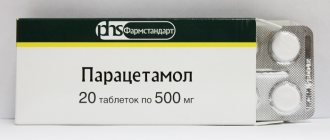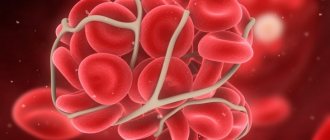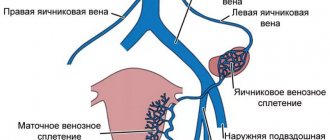What is pregnancy? This is not only a joyful anticipation of the birth of a new life, but also a trigger for the exacerbation of chronic ailments and the emergence of new painful conditions.
Varicose veins of the pelvis during pregnancy in a woman are by no means a rare occurrence, which is fraught with many unpleasant and even tragic complications.
Varicose veins of the pelvis in pregnant women - how to recognize the disease
During pregnancy, a woman may not even be aware of the presence of such a problem as varicose veins of the small pelvis due to the absence of symptoms in case of stage 1 disease.
Alternatively, the symptoms of this disease are similar to the symptoms of other diseases of a urological, gynecological or neurological nature:
- At the initial stage, a woman notices mild discomfort in the legs or pelvic area.
- The lower extremities, like the perineum, begin to swell.
- There is a feeling of fatigue in the groin, lower back, heaviness in the legs.
- Sexual intercourse becomes painful.
- In advanced forms of the disease, a woman feels pain in the pelvic area, and patients report a feeling of fullness.
- There are difficulties when urinating.
If no measures are taken, the disease progresses to the next stage - stage 2 varicose veins, and then stage 3.
Classification
According to the characteristics of the course, there is dilation of the vessels of the perineum and vulva, pelvic venous congestion syndrome. In the first case, the disease develops in the last period of gestation, against the background of varicose veins of the legs. This type of pelvic varicose veins manifests itself by external signs.
Varicose veins of the perineum and vulva are not related to lesions of the pelvis and are diagnosed separately; it can lead to the development of the second form, plethora syndrome, there are no external signs.
Based on etiology, there are two forms:
- primary varicose veins are formed due to incompetence of the vein valves and manifest themselves during pregnancy;
- secondary varicose veins are not associated with pregnancy; they are formed due to diseases and conditions that existed before the onset of pregnancy.
According to localization, pelvic varicose veins are distinguished, when the lesion affects the venous plexuses in the small pelvis, and partial varicose veins, when the vessels are affected.
The development of the disease can be divided into three stages:
- At the first stage, the venous diameter increases to five millimeters, the expansion occurs at the top of the left ovary.
- The second degree of severity is characterized by an expansion of the diameter to one centimeter covering the left ovary.
- At the third stage, the diameter exceeds one centimeter.
How dangerous is the development of pathology?
Having discovered the above symptoms, it is important to immediately seek medical help, since the development of pathology threatens the following problems :
- the vessels of the uterus dilate, which can create difficulties during implantation of the embryo and the normal formation of the placenta, there is a threat of miscarriage or premature birth;
- disruption of uteroplacental blood flow reduces oxygen metabolism, resulting in possible fetal hypoxia;
- irritability, anxiety;
- painful sensations cause aversion to intimacy;
- indications for caesarean section;
- defecation, as well as labor, can cause bleeding and anemia;
- the likelihood of secondary infertility.
Popular misconceptions about varicose veins
Many myths have formed around this disease - such rumors often have no scientific basis and are often unfounded, so they should not become a cause of fear and doubt. Self-medication, as well as the lack of treatment for such a disease, is unacceptable; it is imperative to consult a doctor.
Only the legs suffer
It is believed that only those veins that are located below the level of the heart can suffer from enlargement, which is not true. Pathology of the blood vessels of the arms and shoulder girdle is less common, but is quite possible after damage to the veins of the legs and pelvis.
There are methods that instantly cure the disease
This myth can be classified as a "magic pill" legend, which is not known to exist. Variations of this myth are dangerous because, under its influence, patients often voluntarily correct the prescribed solution or believe that surgery can completely relieve them of their problems and eliminate relapse.
The therapy is carried out by a gynecologist
This statement is not true. This specialist can be the first to make a diagnosis and is involved in managing the pregnancy and monitoring the woman’s condition. Dilation of the pelvic veins is diagnosed by performing an ultrasound, which is performed several times during pregnancy. When a disease is diagnosed, a woman receives a referral to a phlebologist, i.e. a vascular surgeon who, together with a gynecologist, will observe the patient.
You can determine varicose veins at home
The lack of a clear clinical picture of the disease does not allow diagnosing vasodilation at home. A girl may notice painful sensations, heaviness in the lower abdomen, perineum or lower back, which intensifies with exercise, pain during sexual intercourse or urination, but these are not characteristic signs of venous insufficiency. Regardless of the stage of pregnancy, the appearance of such disturbing symptoms is a reason to consult a gynecologist.
Surgery to remove diseased veins increases the burden on the remaining veins
Removing diseased vessels does not in any way affect the condition of the circulatory system as a whole. The risk of relapse after surgery does not disappear, so without prevention and treatment prescribed by the doctor, the disease may reappear.
The disease is inherited - it cannot be avoided
Among the factors determining the development of the disease, heredity comes first, but this does not mean that it is guaranteed to manifest itself in a woman whose relatives suffered from this disease. The likelihood of such an event exists, but in fact, modern medicine has not yet fully studied the true cause of the development of varicose veins.
In addition to heredity, factors influencing the appearance or worsening of varicose veins include obesity and age. Women are at risk because their bodies undergo serious hormonal changes throughout their lives from menstrual cycles to pregnancy and menopause, which causes wear and tear on blood vessels and dysfunction of their valves. Representatives of the fair sex in general suffer more from this disease.
Factors influencing varicose veins of the small pelvis
There are a number of factors that provoke varicose veins.
- significant increase in body weight;
- lifting heavy objects;
- great physical activity;
- bad habits (in particular smoking);
- hereditary predisposition (those who have varicose veins are a hereditary disease should listen to their body from the first days of pregnancy);
- venous insufficiency;
- chronic inflammation of the genital organs;
- the inability of the valves in the vessels to cope with the increased blood flow, resulting in the formation of stagnation of venous blood;
- pressure on the pelvic organs;
- presence of previous abortions and miscarriages;
- growth of the uterus. The uterus enlarged during pregnancy does not allow venous blood to flow through the main vessels. In this regard, the load on small, weaker vessels increases significantly. Congestion of the pelvic veins leads to the occurrence of varicose veins.
Symptoms
As previously written, an accurate diagnosis can only be made after research by a doctor. Not so long ago, doctors could not accurately diagnose this type of complication and prescribed the wrong treatment. This had a number of negative consequences: due to incorrect diagnosis, doctors went so far as to remove the uterus, depriving women of the opportunity to become a mother in the future.
We also recommend reading: Why does your stomach hurt during pregnancy?
In addition to nagging pain, symptoms of venous dilatation of the small pelvis include:
- increased mucous discharge from the vagina;
- the appearance of vascular nodules on the inner surface of the thigh;
- problems with urination (when a woman feels like her bladder is full after urinating);
- gaining weight too quickly in early pregnancy.
To establish an accurate diagnosis, a woman complaining of pain in the lower abdomen is referred for research. First of all, they check the presence of dilated veins using a pelvic ultrasound. Next, blood circulation in the placenta and uterus is examined using Doppler sonography. The possible occurrence of blood clots is checked using transuterine venography.
In extreme cases, when doctors cannot accurately determine the disease, laparoscopy is performed. However, the latter method is used quite rarely.
Forms of the disease - visible and invisible varicose veins
In accordance with the name, visible varicose veins have such an unambiguous symptom as a noticeable discharge of the veins of the external genitalia - stars, nodes on the skin, dilated vessels, which are not difficult to visually mark. At the same time, not the whole picture is visible - internal veins can also be inflamed, but this can only be identified using an ultrasound machine.
Invisible varicose veins also imply inflammation of the vaginal veins. There are no symptoms visible to the naked eye, but there is pain in the lower abdomen. The danger of invisible varicose veins lies in ignoring the disease, while during labor the vessels can rupture during pushing, which will cause bleeding.
If invisible varicose veins are suspected, the expectant mother should undergo an ultrasound examination. A special sensor is inserted into the vagina, which allows the specialist to visually assess the condition of the vessels, the presence of nodes and extensions on them in the uterus and other places inaccessible to the naked eye.
Symptoms of dilated veins of the genital organs during pregnancy include nodes that deform the labia, dryness, itching, and pigmentation are observed in the affected areas. The patient's performance decreases and her mood deteriorates. The presence of such symptoms is a reason to contact a specialist.
Diagnostics
The gold standard for diagnosing the disease, especially during pregnancy, when various invasive interventions and x-rays are excluded, is sonography or ultrasound, and not just two-dimensional, but in combination with Doppler mapping - the ability to visualize vessels using special sensors.
Sonographers and gynecologists offer three degrees of severity of pelvic varicose veins:
- The first degree is the diameter of the vein up to 5 mm in the wall of the uterus and up to 7 mm in other vessels.
- Second degree - vein diameter 7-10 mm.
- Third degree - vein diameter > 10 mm.
The latter type of disease is often combined with the presence of blood clots in the pelvic veins, as well as the consequences of thrombosis in the past - so-called pelvic phleboliths - inclusions impregnated with calcium salts in the walls of varicose veins. These inclusions are not dangerous, but are an “alarm bell” of the potential danger of vein thrombosis.
Fortunately, most often doctors see 1-2 degrees of pelvic varicose veins, which rarely produce pronounced complaints and clinical symptoms, and may be completely asymptomatic.
Additional research methods include various types of tomography (computed X-ray and magnetic resonance imaging), as well as the invasive angiography procedure. However, such serious and expensive procedures are most likely prescribed to patients for completely different reasons, and pelvic varicose veins are simply an additional finding.
Treatment methods
Varicose veins of the pelvis in expectant mothers imply only conservative treatment - surgical intervention is not performed in the 2nd and 3rd trimester.
However, non-surgical therapy can achieve certain results:
- Normalizes the tone of the vascular system.
- Stimulates trophism (nutrition) in tissues.
- Prevents stagnation.
- Normalization of venous circulation.
- Stimulation of blood and lymph outflow.
Treatment involves the comprehensive use of measures, which includes the use of compression stockings and bandages - compression underwear is put on in the morning without getting out of bed, and taken off when going to bed. Physical therapy is also included in the complex treatment.
The use of medications for the treatment of pregnant women is used in cases of acute disease - the patient uses individually selected ointments, and the doctor also prescribes venotonics - such drugs have a positive effect on the condition of the blood, while side effects are minimal.
Preventive actions
To prevent varicose veins from appearing during the happy period of waiting for a child, it is necessary to follow a number of important rules.
- Proper and balanced nutrition excluding fatty, salty, spicy, smoked and sweet foods. Preference should be given to fish, poultry, vegetables, cereals and fruits.
- High physical activity should include daily walking for up to 2 hours.
- Clothing and shoes are selected based on comfort. You should not give preference to high-heeled shoes, tight jeans and decorative underwear. Such things tighten the skin and blood vessels, contributing to the development of congestion.
- To relieve pain and relieve swelling, every evening you need to raise your legs above your head for 10-15 minutes to restore normal blood circulation. In addition, it is recommended that a pregnant woman sleep on her left side to reduce the effect of an enlarged uterus on blood flow.
All women in the “position” should eat right, walk and pay attention to changes in the functioning of their body so that the pregnancy period goes smoothly.
Physical therapy and pelvic varicose veins
Therapeutic exercise allows you to get rid of congestion, therefore, to prevent vascular disease and maintain a favorable condition of the blood vessels, swimming, walking on stairs and therapeutic exercise are recommended. Strong physical activity is undesirable as it can aggravate the course of the disease. Therefore, in order to minimize the consequences of the disease for a woman and child, it is worth choosing a set of exercises together with a doctor.
In most cases, recommendations include exercises in a lying position - they are available for pregnant women of any age:
- The “Bicycle” exercise is known to everyone, but it is no less effective. It must be performed while lying on a gymnastics mat, with your arms along your body - slowly raising your legs, bent at the knees, and simulating pedaling. The exercise must be performed in several approaches until slight fatigue appears.
- The “Boat” exercise also tones several muscle groups well. It is performed lying on the back, the limbs are located along the body. At the same time, we raise the upper and lower limbs above the floor level, lingering at the top point for a few seconds, after which the body returns to its original position.
- The “Birch” exercise is performed lying on your back, with your hands on your belt. We raise our straight legs up together with the pelvis, supporting the lower back with our hands - the lower part of the body should be directed perpendicular to the floor, at the top point we linger for a few seconds and return to the starting position.
Such gymnastics can be easily performed at home. It is also important to drink enough fluids and follow a diet for varicose veins - avoid fried foods, canned foods, pickles, smoked foods, etc.
Prevention
Particular attention to health should be paid to women who are genetically predisposed to varicose veins and people involved in sports. Periodic diagnosis of the condition of blood vessels before childbirth and before pregnancy will eliminate the occurrence of pathologies and complications. Following a diet and a healthy lifestyle, eliminating bad habits will have a positive effect on the entire period of pregnancy. Moderate physical activity, walking, and avoiding tight and uncomfortable clothing will be helpful.
How does childbirth occur during illness?
The risk of vascular rupture and bleeding during labor does not allow for a safe vaginal birth; in such cases, a caesarean section is recommended. After collecting anamnesis and assessing the condition of the woman in labor, the obstetrician decides on the choice of method of delivery.
If there are no natural contraindications, a woman should wear compression stockings or wrap her legs with an elastic bandage - this will prevent complications, since in the process of pushing a reverse flow of blood is possible, which can cause thrombosis or inflammation of the veins.











